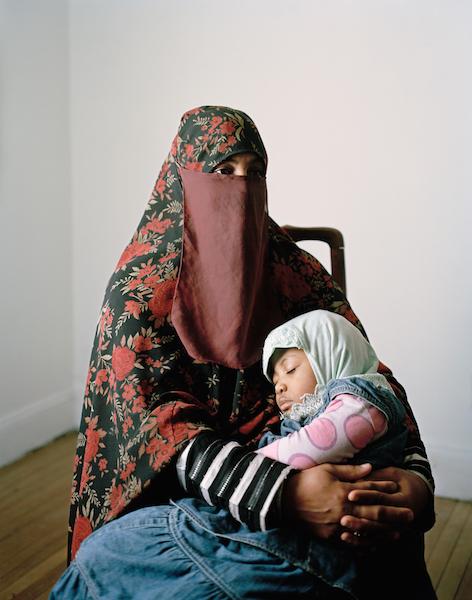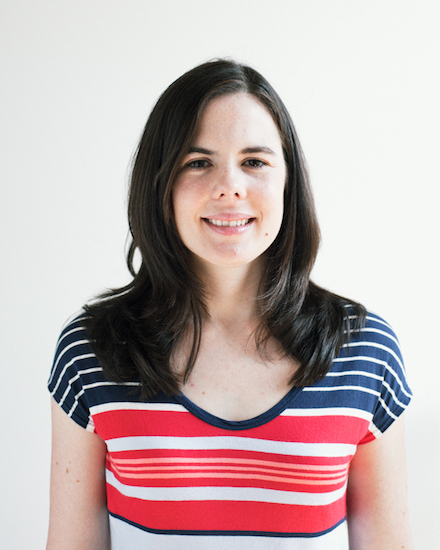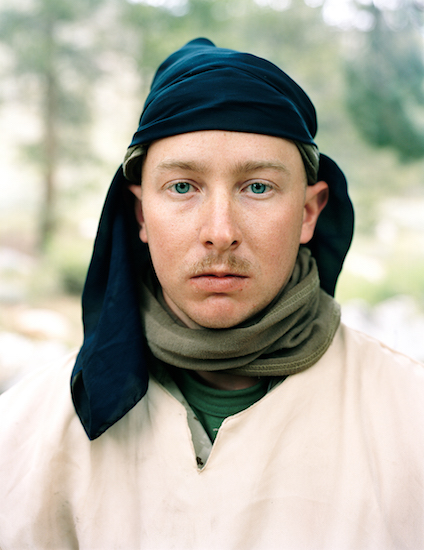Art Talk with Claire Beckett

“I really like the capacity of pictures to tell stories and raise questions about people, about the way we live, about the conditions in which we live our lives. And so I think for me, portraiture is about all those things. It's about an opportunity to ask about a person or a society or even myself.” — Claire Beckett
For artist Claire Beckett, photography is a way of learning about the world. As she described during a recent phone interview, "[Photography] is about an opportunity to ask about a person or a society or even myself." In series such as The Converts and In Training, the Boston-based photographer homes in on the particulars of affinity groups such as the military or Islamic converts, while at the same time pondering questions around what it means to belong, what it means to be an outsider, what it means to be American. An award-winning photographer, Beckett's work has been shown in exhibits at the Nelson-Atkins Museum of Art, the deCordova Museum, and Mass MoCA among other national and international museums. Her 2013 portrait April and her daughter Sarah was also a finalist for the Smithsonian National Portrait Gallery's 2016 Outwin Boochever Portrait Competition. Here's more from Beckett on becoming an artist, why she chooses to work with a time-intensive process, and what she's learned through her work.
NEA: What’s your origin story as an artist?
CLAIRE BECKETT: I have always done art since I was a little kid. When I was in high school, I did a lot of ceramics, and I was really, really involved with wheel-throwing. My ceramics teacher retired when I was 15, and I missed her so much that I refused to take ceramics with the new teacher. So I decided to try this other thing called photography, which I thought I would really hate. It took about two days in the photography class before I realized it was my favorite thing in the world, and that it came really naturally to me. Even since I was a kid, I always really wanted to be able to have my voice be heard and express my ideas about the world—not so much about myself, but bigger questions and ideas, I think photography was a way that I could do that, that I could show you something, or let you feel something…. I went on to do a lot of things, but I always kept coming back to photography and coming back to wanting to make meaning of the world around me as an artist. I did that through photography and I did that through studying anthropology, and I did that through serving in the Peace Corps, but it always kept coming back to making pictures as part of a conversation.
NEA: Do you remember the moment you made the conscious decision that you were going to be an artist?
BECKETT: I think I was an artist way before I realized I was an artist, you know? I didn't call myself an artist, until maybe I was a graduate student, but I practiced like an artist. As artists we talk about having an artist's practice, or a series of habits basically that add up to one's life as an artist. For everybody it's different, but going to the studio, or making pictures, or meeting with artists to talk about things, or whatever it is. Sketching in a sketchbook. Reading to generate ideas. Those set of habits are, I think, what forms the life of an artist. and I think I had that life since I was a teenager, really. It wasn't until I was a number of years older that I actually learned to call myself an artist, and I guess it's a kind of a confidence to be able to own up to who you really are and what you really do in a world that's not necessarily friendly to artists or doesn't make it seem like an easy choice to be a professional artist. I guess art found me, rather than me declaring myself an artist.
NEA: I know you don’t work exclusively in portraiture, but I first discovered your work at the National Portrait Gallery as part of the Outwin Boochever Portrait Competition, and so I’d like to talk about that aspect of your photography practice. How you define portraiture, or what does it mean to you to make someone's portrait?
BECKETT: That's really complicated, actually. So a portrait is a likeness of a person usually, I would say, in broad terms. But to make a portrait of a person, I think I'm also making a portrait of myself in that process or providing you with an insight into my opinions, or my world view or something. I think the photograph should be as much about the artist and what she's thinking about as it is about something about the person sitting for the picture…. I really like the capacity of pictures to tell stories and raise questions about people, about the way we live, about the conditions in which we live our lives. And so I think for me, portraiture is about all those things. It's about an opportunity to ask about a person or a society or even myself.

NEA: To follow up on that, I'm interested in that idea of thinking about making pictures as a way of asking questions. What are the questions that you find yourself pursuing, consciously or unconsciously?
BECKETT: Usually in my projects there are series of specific questions which guide me. [The photography series] Simulating Iraq had to do with a cultural immersion in military training so there were a series of specific questions that pertained to U.S. military training, or the life of a soldier, or the life of a visiting role player in that context. I wanted to know what that's like; I get really interested in the facts and the details that relate to the material…. But then there are some bigger questions that come up over and over again for me in my work: questions about American identity, questions about the idea of the cultural melting pot in America, which is something that was a really big idea when I was growing up. Who are we all as a collective? What do we stand for? How do we represent ourselves? How do we relate to others? How do we define the in-group and the out-group?
When I was a Peace Corp volunteer in the Republic of Benin the experience of living outside of my own society for an extended period of time and having to come to terms with integrating myself into a different culture has cast a long presence over my whole artmaking process and the way I look at the world. So this idea of, "Who is an American?" I came to that very question by standing outside of America as an American and looking in for a long time. I think those questions are central to me no matter what I'm looking at in terms of specific content.
NEA: Can you please talk about making the photograph April and her daughter Sarah, which is the portrait that is in the Boochever competition exhibit?
BECKETT: April and her daughter Sarah is from my Converts Series, which is a project about Americans who have converted to Islam. For those photographs, the thing that I had to do was find a way into that Muslim community in order to meet people, in order to take the pictures. I ended up joining a class in Cambridge, Massachusetts, for women who are converting to Islam, or who had interest in learning about Islam…. I went and I asked to join the class, if I could sit in and meet the women. I wasn't even asking for people to photograph yet at that point in time, as much as I was trying to learn about Islam—I'm not Muslim—learn about the experience of converting, learn about the successes and the trials that the women might be experiencing. I have been attending that class for about five years, and I still go as often as I can because it's really helped me understand my work. It’s a non-direct way to learning about my work, and I don't have to continuously be studying things, but I can stay in touch with it and keep learning through this class. I had to find a way to gain credibility in the community and make some friends in the community so that's what I did.
In terms of meeting the actual people that sit for the pictures, that [happened] through meeting in class, or meeting a mutual friend in class, or going to a social event at the mosque where there were converts present and introducing myself. In the case of April, I met her at an event at the mosque. There's a mosque in Boston that has a lot of programming for converts, and I met April at a Ramadan fast-breaking evening that was a special event for converts and their families. I made an appointment to go to April's home, and showed up with all my equipment and my assistant and set up the picture in her house.
I photograph with a large format film camera. It's a four-by-five inch camera, which means it makes a four-by-five inch negative. Envision an old-school Civil War [camera set-up], dark cloth over the head, light on a stick—that's the technology we're talking about. I use a modern high-quality version of that setup…. It’s all very slow and worked out along with the person I'm photographing. Because of the camera being large and on a tripod, and the lights, it's not a fast snap, a [take the]picture and run type of a situation. It’s very much a slow, steady getting-to-know-you, talking through the picture with the person photographing. You can actually take the picture really quickly like a modern camera, but the setup is a little bit more cumbersome, so to get the picture focused and get the composition right, it does require the person to sit still for an extended period of time, and that has an impact on the final photograph as well.
NEA: I'm intrigued by the fact that you're using a more cumbersome process that requires a lot of you, technically, and also so much patience on the part of the subject. What makes the challenges worth it for you?
BECKETT: I discovered that, for me, the extra effort made much better photographs. Even when you're viewing the photograph on the ground glass, as you compose it, it's difficult to see the edges of the frame because it's very dark and it's vignetted in your viewfinder. You have to make a really concerted effort to check the corners of your frame to make sure there's not something weird there, or something cut off, or something odd-looking. All that effort makes me move more slowly, and I just do better work. So I really like it for that. Also I think, in the era of phones, smartphones, cameras being everywhere, finding a way to differentiate to the public when I'm working with them between the picture that I want to make [with this camera], and the picture that I can make with my phone, is really helpful. It shows a serious intent that’s going to require something from them in terms of their participation. I think it's clearer as to what's going on, and it's like a novel moment in a person's life to be photographed with this camera. It’s not like an everyday selfie. It's this huge thing that takes a long time, and there's an anticipation about what it will look like, and an excitement to see the results. And you have to wait. I have to take the film home. I have to unload it. I have to get to the lab. I have to process it. I have to take it to the different lab and scan it, and then process it on my computer before I can share it with anyone. So there's all this anticipation as well.
NEA: I'm curious if/or how you think about the role of the viewer in terms of how they relate to your work. What is it that you want them to take away from spending time with your pictures?
BECKETT: In some ways the viewer is always there. For example, in the Converts Project, this burden of prejudice against Muslims in America is there always, right? I don't need to put that inside the photograph. I don't even need to write about it; that is always in the background for the viewer because it so permeates our existence in 2016 in the United States. I think that's a really interesting presence for the viewer. It's almost like they're doing part of the work for me, that I don't have to spell out, xenophobia to you in my picture, because you know about that already if you're walking down the street in America in 2016. In a way, the viewer is always activating the picture.
From another point of view, I really like my pictures to be open. For example, with the project Simulating Iraq, I've had people who had very different views of the wars in Iraq and Afghanistan. Both find their point of view expressed in the photograph. There's an ambiguity there that is very much by design on my part. I have a set of ideas, but I'm not so interested in convincing the viewer of my ideas as in allowing the viewer to think about her ideas and to be challenged in those ideas. For me, as an artist, that's the interesting work. I'd rather have something complex and nuanced that doesn't deliver a firm final verdict and allow the viewer to have the space to do that herself.

NEA: I know you're a visiting faculty member at the school of the MFA in Boston. What do you want your students to walk away with after working with you?
BECKETT: As a teacher I would say my job is not to convince my students to turn out just like me. I teach undergrads; I teach grad student; I teach people that later in life probably will do all manner of things, jobs, careers, interests. Many will become professional artists, but I don't think that that's the goal of my teaching. I really like photography as a tool to learn about the world. It’s a great medium to go deep in and learn about and become an expert at, make really wonderful photographs, have great technical skills, know how to be a professional. But that stuff, I think, is transferrable to other things you do in life. I really want my students to develop critical thinking, critical engagement with the world, to be adventurous. It sounds really cheesy, but I do think making a difference in the world is important so those are the things that I try to work with my students on. Then they go on to do all kinds of things. It's exciting to see what they end up doing with their lives.
NEA: You’ve said that photography reveals things about you to yourself. Could you talk a little bit more about that--what you've learned about yourself through making these portraits of others?
BECKETT: In some ways, I can't remember the person I was before; I wish I did. I think the projects that I tend to take on take me pretty far outside my own life. For example, the two projects I did with the U.S. Military, taught me an awful lot about the military. I really didn't know how much I didn't know about our present-day military until I got pretty deeply involved. I am not from a family with a current record of military service. We have lots of relatives who have served in previous eras, but nobody currently serving, or recently serving, so I think I was very ignorant of what it takes to be a soldier. What is the career path of a soldier? Why is someone motivated to join the military? What are the various reasons that someone might do that? I think [these projects] showed me a lot about parts of the U.S. that I'm not familiar with, like that there are a wide range of reasons that people have for joining the military, for serving, for having long military careers, for choosing different kinds of jobs. That was all very eye-opening for me, and I would not have ever learned that stuff if I hadn't done these projects I think that I would have remained a little bit ignorant and trapped in a certain world view that has to do with where I live and what I do for a living and who my family is. I just didn't have access to that, the needed experience, in any other way.
NEA: My final question: please finish the sentence: The arts matter because…
BECKETT: The arts matter because people matter. That's enough, I think.




